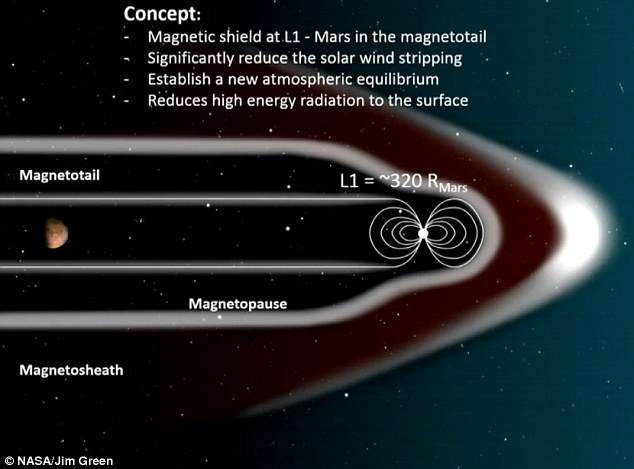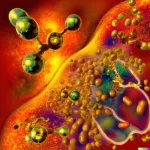By Jan Spacek, Steven Benner, and Max Fagin
Cite as: Spacek, J., Benner, S. A., Fagin, M. (2022) “The Mars’ magnetic shield would not work”. Primordial Scoop, e20221114. https://doi.org/10.52400/ZJQO9069.
The thin atmosphere above Mars, near the triple point of water at the highest surface temperatures routinely seen, is a major impediment to “terraforming” the planet. Large amounts of surface liquid water are not possible at this atmospheric pressure. They become possible only if the pressure is increased.
One idea that recurs in the popular science literature seeks to increase the atmospheric pressure above Mars by preventing the loss of the thin Mars’ atmosphere to space. When that loss is attributed to the erosion of the atmosphere due to the solar wind, the problem is often attributed to the absence of a magnetic field around Mars. To prevent that erosion, it is occasionally suggested that an engineered shield be placed in a position to shield Mars from the solar wind.
This idea is not new. It was proposed, perhaps for the first time, 5 years ago by James Green, then NASA’s Chief Scientist in a non-peer reviewed venue. (https://phys.org/news/2017-03-nasa-magnetic-shield-mars-atmosphere.html)
He repeated the suggestion of using a magnetic shield before the recent meeting of the Mars Society in Temple, suggesting that it might help terraform Mars. (https://youtu.be/F_q029Y1hDQ?t=4190)
The idea behind the magnetic shield is straight forward, and may seem logical under the assumption that the stripping of the carbon dioxide atmosphere by the solar wind is quantitatively significant. Here, a magnetic shield placed in Solar orbit at the Martian L1 Lagrange point would deflect the solar wind. Mars, in its leeward shadow, would be protected. Over time, the Martian atmospheric pressure would increase as carbon dioxide continued to emerge from the Martian crust and mantle. That would in turn allow the Martian surface temperature to increase, causing positive feedback as more solid carbon dioxide presently frozen at the poles would sublime.
The obvious question asks the time scale over which this terraforming impact might be felt. Dr. Green cited the rate of Mars atmosphere stripping due to solar wind impact of 1.3 kg per second, as estimated by the MAVEN mission. This, he suggested, would cause the atmosphere to achieve a new equilibrium, given the assumption that the “Martian atmosphere, is in equilibrium with the solar wind. That means what it strips, is being outgassed…”.
It is important to quantitate this process. The rate of atmosphere loss of 1 kg per second corresponds to a loss of ~3 · 106 kg per (Earth) year. The total mass of the Mars atmosphere is estimated to be ~3 · 1016 kg. That means that in a given (Earth) year, Mars loses and regenerates ~10-9 of its atmosphere (that is 0.0000001%).
Assuming linearity over time, this calculates to give a statement that, after one millennium of successful use of the L1 magnetic shield with 100% efficiency, Mars would increase its atmosphere’s mass by ~30 billion kg. That is just 0.0001% of the total current atmosphere above Mars. This translates into a requirement for ten million years to increase the mass of the Martian atmosphere by a single percent.
This is, of course, an upper limit, as the expected efficiency of the magnetic shield is less than 100%.
Thus, terraforming Mars by preventing the stripping of its atmosphere by solar wind is many orders of magnitude too slow to be relevant for our descendants living on Mars in any way in the next millennia.
The real time exchange between Green and the authors provides a sense of the dynamics, In the Q&A after Dr. Green’s presentation, the first author (https://youtu.be/F_q029Y1hDQ?t=5340) offered the above mentioned back-of-the-envelope calculation. Green agreed that increasing the Martian atmospheric pressure “would take a long time”. Further pressed, Green suggested “if [solar wind protection] was the only process, it does take thousands of years” to increase Mars’ atmosphere to one bar (https://youtu.be/F_q029Y1hDQ?t=5459). This estimate of the required time appears to be about 11 orders of magnitude too low.
On the other side of the ASU Ballroom, Max Fagin went deeper into his calculations and found that the same amount of power required for the magnetic shield (estimated by Dr. Green to be a sustained 65 GW, about the power output of modern day Germany) was unlikely to be allocated by a power limited terraforming effort to a project as inefficient as the magnetic shield. The same 65 GW, if expended as heat on the surface of Mars, would be enough to directly liberate CO2 from the south pole cap or the subsurface regolith, thickening the atmosphere at 10’s of thousands of kg per second, (~1012 kg per Earth year), a million times faster than the leak rate that the shield was designed to stop. So in practice, the same effective replacement of the atmosphere being lost to space could be achieved for 0.0001% of the power of the magnetic shield, leaving the remainder of the 65 GW free for other projects more useful to terraforming (such as O2 production, or synthesizing and injecting UV absorbing gasses into the upper atmosphere).
Steven Benner raised another objection (https://youtu.be/F_q029Y1hDQ?t=5479). Solar wind stripping is likely not the only process relevant to the observation that the Martian atmospheric pressure is near the triple point of water. A sizable fraction of the accessible surface of Mars remains basalt. A higher pressure that allowed abundant surface water would lead to corrosion of the basalt. That corrosion would render the surface water alkaline. This alkaline water would absorb atmospheric carbon dioxide, forming carbonate minerals, thus reducing the pressure to the triple point. At this point, corrosion would cease until more outgassing of carbon dioxide provided more pressure. Thus, it may be that the basalt-atmosphere interactions restrain the atmospheric pressure to remain near the triple point.
This, of course, has implications for how atmospheric pressure should be increased to terraform Mars. With or without a magnetic shield, a higher pressure cannot be maintained with carbon dioxide or any other gas that interacts with surface petrology. Rather, that pressure must be maintained by a noninteractive gas, such as dinitrogen, argon, neon, or eventually dioxygen.



